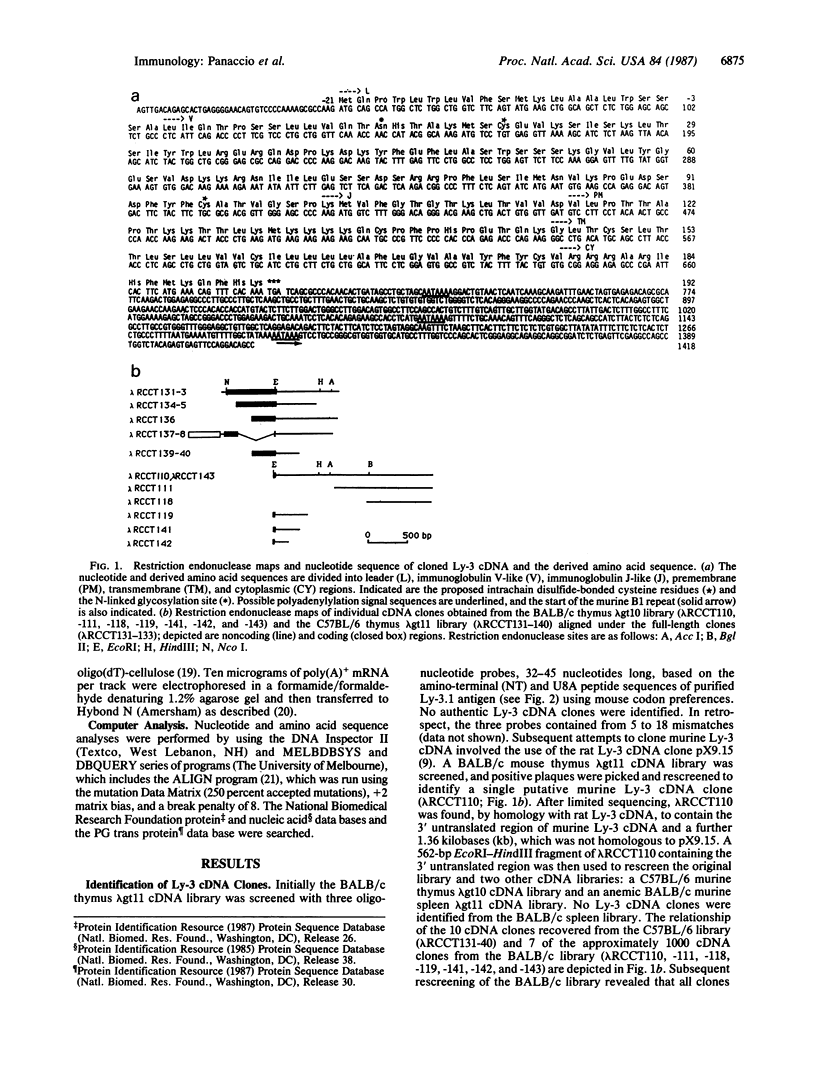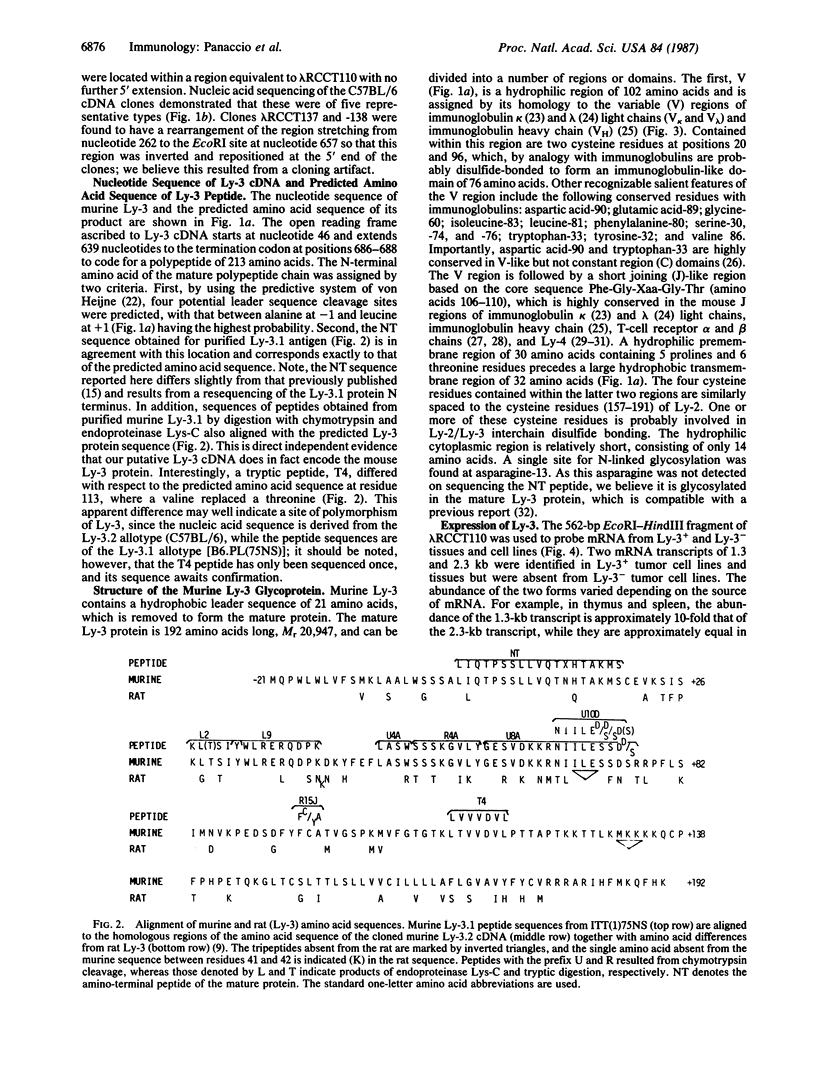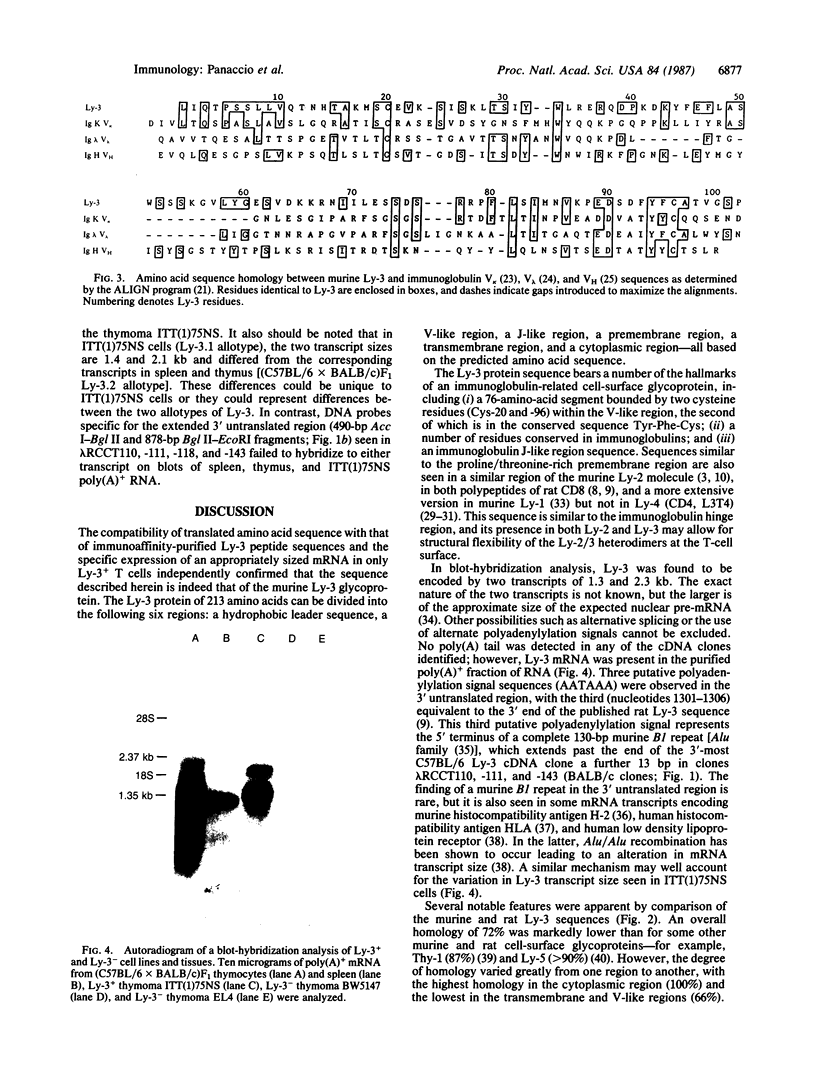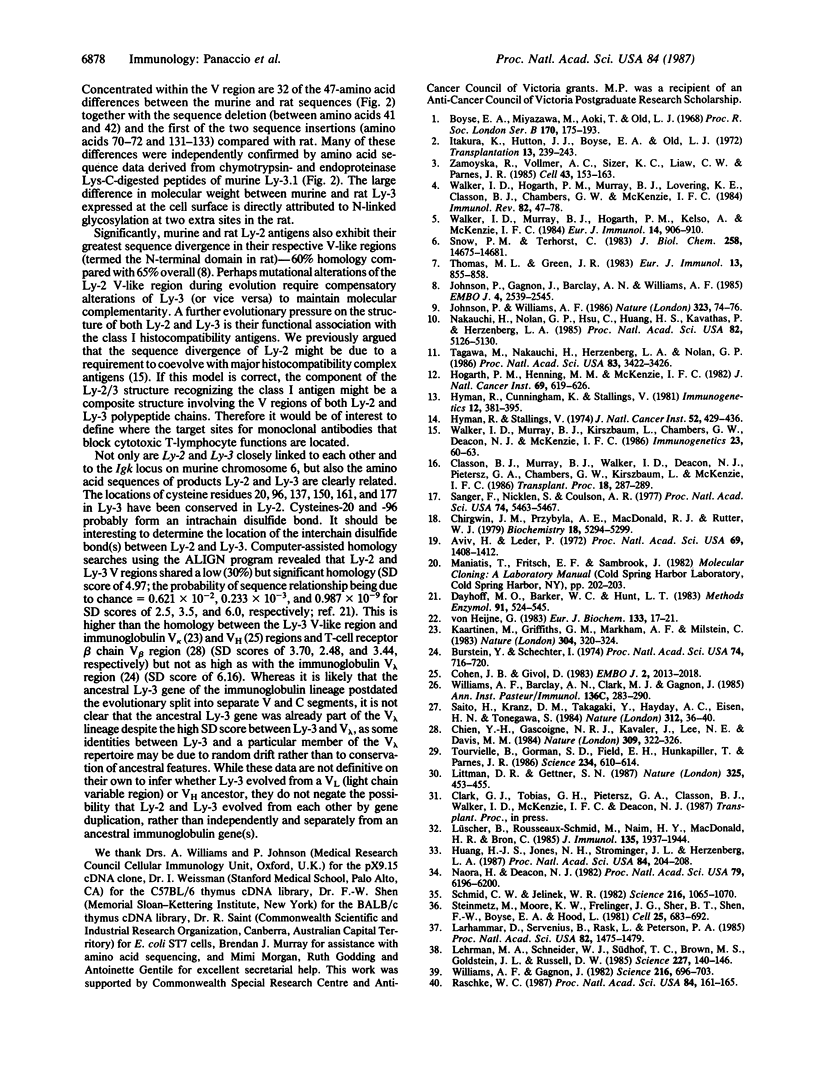Abstract
The murine Ly-2/3 glycoprotein is a surface marker of T cells restricted by class I major histocompatibility complex antigens. It is a disulfide-bonded heterodimer in which either the alpha or alpha' polypeptide chain encoded by Ly-2 is covalently linked to the beta polypeptide chain encoded by Ly-3. The nucleotide and predicted amino acid sequence of the murine Ly-3 cDNA, isolated by using the rat Ly-3 cDNA clone pX9.15, together with the amino acid sequence of Ly-3.1 peptides and the N terminus, are presented here. The alignment of peptide data from the Ly-3.1 antigen with that of the predicted amino acid sequence of the Ly-3.2 antigen confirmed that the putative Ly-3 cDNA clones do in fact encode the Ly-3 protein. The Ly-3.2 cDNA clones encode a protein of 213 amino acids, which includes a 21-residue leader sequence and structural features in common with immunoglobulin variable, joining, and hinge regions. Searches of protein data bases revealed that Ly-3 is a member of the immunoglobulin superfamily with significant homology to Ly-2, immunoglobulin variable region kappa and lambda light chains, and the beta chain of the T-cell receptor. A single N-linked glycosylation site was found at asparagine-13. The relative expression of two mRNA species (approximately 1.3 and 2.3 kilobases) varied according to the source of mRNA. A murine B1 repeat was located in the 3' untranslated region of Ly-3 cDNA clones.
Full text
PDF




Images in this article
Selected References
These references are in PubMed. This may not be the complete list of references from this article.
- Aviv H., Leder P. Purification of biologically active globin messenger RNA by chromatography on oligothymidylic acid-cellulose. Proc Natl Acad Sci U S A. 1972 Jun;69(6):1408–1412. doi: 10.1073/pnas.69.6.1408. [DOI] [PMC free article] [PubMed] [Google Scholar]
- Boyse E. A., Miyazawa M., Aoki T., Old L. J. Ly-A and Ly-B: two systems of lymphocyte isoantigens in the mouse. Proc R Soc Lond B Biol Sci. 1968 Jun 11;170(1019):175–193. doi: 10.1098/rspb.1968.0032. [DOI] [PubMed] [Google Scholar]
- Burstein Y., Schechter I. Amino acid sequence of the NH2-terminal extra piece segments of the precursors of mouse immunoglobulin lambda1-type and kappa-type light chains. Proc Natl Acad Sci U S A. 1977 Feb;74(2):716–720. doi: 10.1073/pnas.74.2.716. [DOI] [PMC free article] [PubMed] [Google Scholar]
- Chien Y. H., Gascoigne N. R., Kavaler J., Lee N. E., Davis M. M. Somatic recombination in a murine T-cell receptor gene. Nature. 1984 May 24;309(5966):322–326. doi: 10.1038/309322a0. [DOI] [PubMed] [Google Scholar]
- Chirgwin J. M., Przybyla A. E., MacDonald R. J., Rutter W. J. Isolation of biologically active ribonucleic acid from sources enriched in ribonuclease. Biochemistry. 1979 Nov 27;18(24):5294–5299. doi: 10.1021/bi00591a005. [DOI] [PubMed] [Google Scholar]
- Classon B. J., Murray B. J., Walker I. D., Deacon N. J., Pietersz G. A., Chambers G. W., Kirszbaum L., McKenzie I. F. Molecular analysis of Ly-2/3 and L3T4 molecules. Transplant Proc. 1986 Apr;18(2):287–289. [PubMed] [Google Scholar]
- Cohen J. B., Givol D. Allelic immunoglobulin VH genes in two mouse strains: possible germline gene recombination. EMBO J. 1983;2(11):2013–2018. doi: 10.1002/j.1460-2075.1983.tb01693.x. [DOI] [PMC free article] [PubMed] [Google Scholar]
- Dayhoff M. O., Barker W. C., Hunt L. T. Establishing homologies in protein sequences. Methods Enzymol. 1983;91:524–545. doi: 10.1016/s0076-6879(83)91049-2. [DOI] [PubMed] [Google Scholar]
- Hogarth P. M., Henning M. M., McKenzie I. F. Alloantigenic phenotype of radiation-induced thymomas in the mouse. J Natl Cancer Inst. 1982 Sep;69(3):619–626. [PubMed] [Google Scholar]
- Huang H. J., Jones N. H., Strominger J. L., Herzenberg L. A. Molecular cloning of Ly-1, a membrane glycoprotein of mouse T lymphocytes and a subset of B cells: molecular homology to its human counterpart Leu-1/T1 (CD5). Proc Natl Acad Sci U S A. 1987 Jan;84(1):204–208. doi: 10.1073/pnas.84.1.204. [DOI] [PMC free article] [PubMed] [Google Scholar]
- Hyman R., Cunningham K., Stallings V. Effect of gene dosage on cell-surface expression of Thy-1 antigen in somatic cell hybrids between Thy-1- Abelson-leukemia-virus induced lymphomas and Thy-1+ mouse lymphomas. Immunogenetics. 1981;12(3-4):381–395. doi: 10.1007/BF01561678. [DOI] [PubMed] [Google Scholar]
- Hyman R., Stallings V. Complementation patterns of Thy-1 variants and evidence that antigen loss variants "pre-exist" in the parental population. J Natl Cancer Inst. 1974 Feb;52(2):429–436. doi: 10.1093/jnci/52.2.429. [DOI] [PubMed] [Google Scholar]
- Itakura K., Hutton J. J., Boyse E. A., Old L. J. Genetic linkage relationships of loci specifying differentiation alloantigens in the mouse. Transplantation. 1972 Mar;13(3):239–243. doi: 10.1097/00007890-197203000-00007. [DOI] [PubMed] [Google Scholar]
- Johnson P., Gagnon J., Barclay A. N., Williams A. F. Purification, chain separation and sequence of the MRC OX-8 antigen, a marker of rat cytotoxic T lymphocytes. EMBO J. 1985 Oct;4(10):2539–2545. doi: 10.1002/j.1460-2075.1985.tb03968.x. [DOI] [PMC free article] [PubMed] [Google Scholar]
- Johnson P., Williams A. F. Striking similarities between antigen receptor J pieces and sequence in the second chain of the murine CD8 antigen. Nature. 1986 Sep 4;323(6083):74–76. doi: 10.1038/323074a0. [DOI] [PubMed] [Google Scholar]
- Kaartinen M., Griffiths G. M., Markham A. F., Milstein C. mRNA sequences define an unusually restricted IgG response to 2-phenyloxazolone and its early diversification. 1983 Jul 28-Aug 3Nature. 304(5924):320–324. doi: 10.1038/304320a0. [DOI] [PubMed] [Google Scholar]
- Larhammar D., Servenius B., Rask L., Peterson P. A. Characterization of an HLA DR beta pseudogene. Proc Natl Acad Sci U S A. 1985 Mar;82(5):1475–1479. doi: 10.1073/pnas.82.5.1475. [DOI] [PMC free article] [PubMed] [Google Scholar]
- Lehrman M. A., Schneider W. J., Südhof T. C., Brown M. S., Goldstein J. L., Russell D. W. Mutation in LDL receptor: Alu-Alu recombination deletes exons encoding transmembrane and cytoplasmic domains. Science. 1985 Jan 11;227(4683):140–146. doi: 10.1126/science.3155573. [DOI] [PMC free article] [PubMed] [Google Scholar]
- Littman D. R., Gettner S. N. Unusual intron in the immunoglobulin domain of the newly isolated murine CD4 (L3T4) gene. 1987 Jan 29-Feb 4Nature. 325(6103):453–455. doi: 10.1038/325453a0. [DOI] [PubMed] [Google Scholar]
- Lüscher B., Rousseaux-Schmid M., Naim H. Y., MacDonald H. R., Bron C. Biosynthesis and maturation of the Lyt-2/3 molecular complex in mouse thymocytes. J Immunol. 1985 Sep;135(3):1937–1944. [PubMed] [Google Scholar]
- Nakauchi H., Nolan G. P., Hsu C., Huang H. S., Kavathas P., Herzenberg L. A. Molecular cloning of Lyt-2, a membrane glycoprotein marking a subset of mouse T lymphocytes: molecular homology to its human counterpart, Leu-2/T8, and to immunoglobulin variable regions. Proc Natl Acad Sci U S A. 1985 Aug;82(15):5126–5130. doi: 10.1073/pnas.82.15.5126. [DOI] [PMC free article] [PubMed] [Google Scholar]
- Naora H., Deacon N. J. Relationship between the total size of exons and introns in protein-coding genes of higher eukaryotes. Proc Natl Acad Sci U S A. 1982 Oct;79(20):6196–6200. doi: 10.1073/pnas.79.20.6196. [DOI] [PMC free article] [PubMed] [Google Scholar]
- Raschke W. C. Cloned murine T200 (Ly-5) cDNA reveals multiple transcripts within B- and T-lymphocyte lineages. Proc Natl Acad Sci U S A. 1987 Jan;84(1):161–165. doi: 10.1073/pnas.84.1.161. [DOI] [PMC free article] [PubMed] [Google Scholar]
- Saito H., Kranz D. M., Takagaki Y., Hayday A. C., Eisen H. N., Tonegawa S. A third rearranged and expressed gene in a clone of cytotoxic T lymphocytes. Nature. 1984 Nov 1;312(5989):36–40. doi: 10.1038/312036a0. [DOI] [PubMed] [Google Scholar]
- Sanger F., Nicklen S., Coulson A. R. DNA sequencing with chain-terminating inhibitors. Proc Natl Acad Sci U S A. 1977 Dec;74(12):5463–5467. doi: 10.1073/pnas.74.12.5463. [DOI] [PMC free article] [PubMed] [Google Scholar]
- Schmid C. W., Jelinek W. R. The Alu family of dispersed repetitive sequences. Science. 1982 Jun 4;216(4550):1065–1070. doi: 10.1126/science.6281889. [DOI] [PubMed] [Google Scholar]
- Snow P. M., Terhorst C. The T8 antigen is a multimeric complex of two distinct subunits on human thymocytes but consists of homomultimeric forms on peripheral blood T lymphocytes. J Biol Chem. 1983 Dec 10;258(23):14675–14681. [PubMed] [Google Scholar]
- Steinmetz M., Moore K. W., Frelinger J. G., Sher B. T., Shen F. W., Boyse E. A., Hood L. A pseudogene homologous to mouse transplantation antigens: transplantation antigens are encoded by eight exons that correlate with protein domains. Cell. 1981 Sep;25(3):683–692. doi: 10.1016/0092-8674(81)90175-6. [DOI] [PubMed] [Google Scholar]
- Tagawa M., Nakauchi H., Herzenberg L. A., Nolan G. P. Formal proof that different-size Lyt-2 polypeptides arise from differential splicing and post-transcriptional regulation. Proc Natl Acad Sci U S A. 1986 May;83(10):3422–3426. doi: 10.1073/pnas.83.10.3422. [DOI] [PMC free article] [PubMed] [Google Scholar]
- Thomas M. L., Green J. R. Molecular nature of the W3/25 and MRC OX-8 marker antigens for rat T lymphocytes: comparisons with mouse and human antigens. Eur J Immunol. 1983 Oct;13(10):855–858. doi: 10.1002/eji.1830131014. [DOI] [PubMed] [Google Scholar]
- Tourvieille B., Gorman S. D., Field E. H., Hunkapiller T., Parnes J. R. Isolation and sequence of L3T4 complementary DNA clones: expression in T cells and brain. Science. 1986 Oct 31;234(4776):610–614. doi: 10.1126/science.3094146. [DOI] [PubMed] [Google Scholar]
- Walker I. D., Hogarth P. M., Murray B. J., Lovering K. E., Classon B. J., Chambers G. W., McKenzie I. F. Ly antigens associated with T cell recognition and effector function. Immunol Rev. 1984 Dec;82:47–77. doi: 10.1111/j.1600-065x.1984.tb01117.x. [DOI] [PubMed] [Google Scholar]
- Walker I. D., Murray B. J., Hogarth P. M., Kelso A., McKenzie I. F. Comparison of thymic and peripheral T cell Ly-2/3 antigens. Eur J Immunol. 1984 Oct;14(10):906–910. doi: 10.1002/eji.1830141009. [DOI] [PubMed] [Google Scholar]
- Walker I. D., Murray B. J., Kirszbaum L., Chambers G. W., Deacon N. J., McKenzie I. F. The amino-terminal sequences of Ly-2 and Ly-3. Immunogenetics. 1986;23(1):60–63. doi: 10.1007/BF00376523. [DOI] [PubMed] [Google Scholar]
- Williams A. F., Barclay A. N., Clark M. J., Gagnon J. Cell surface glycoproteins and the origins of immunity. Ann Inst Pasteur Immunol. 1985 Mar-Apr;136C(2):283–294. doi: 10.1016/s0769-2625(85)80060-x. [DOI] [PubMed] [Google Scholar]
- Williams A. F., Gagnon J. Neuronal cell Thy-1 glycoprotein: homology with immunoglobulin. Science. 1982 May 14;216(4547):696–703. doi: 10.1126/science.6177036. [DOI] [PubMed] [Google Scholar]
- Zamoyska R., Vollmer A. C., Sizer K. C., Liaw C. W., Parnes J. R. Two Lyt-2 polypeptides arise from a single gene by alternative splicing patterns of mRNA. Cell. 1985 Nov;43(1):153–163. doi: 10.1016/0092-8674(85)90020-0. [DOI] [PubMed] [Google Scholar]
- von Heijne G. Patterns of amino acids near signal-sequence cleavage sites. Eur J Biochem. 1983 Jun 1;133(1):17–21. doi: 10.1111/j.1432-1033.1983.tb07424.x. [DOI] [PubMed] [Google Scholar]



